Naqsh-e Rustam: Ancient Treasures & Zoroastrian Legacy
Located in the city of Marvdasht, Iran, Naqsh-e Rustam stands as an archaeological treasure trove.
This site boasts majestic rock-cut tombs and intricate reliefs that offer a captivating glimpse into the rich history of ancient Persia.
Naqsh-e Rustam Historical Background
As you wander through this captivating site, you're not only exploring the remains of a bygone era but also uncovering the tales of mighty rulers and their enduring legacies.
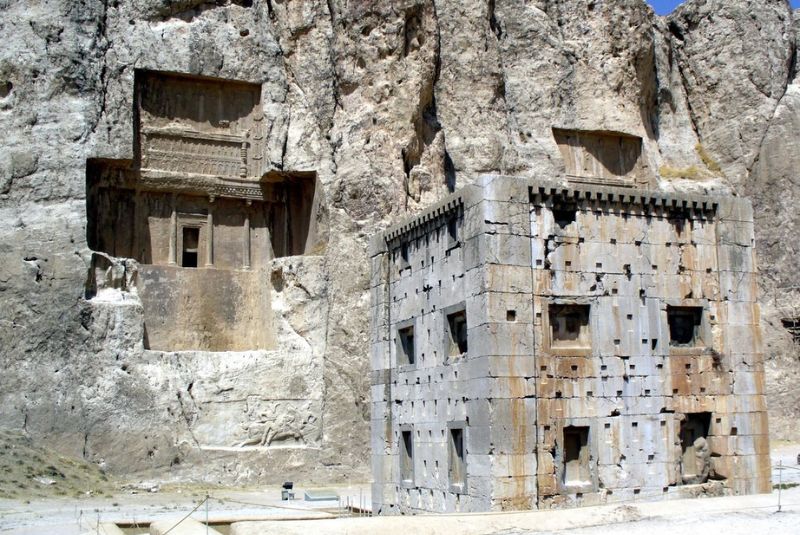
Ancient Origins
Naqsh-e Rustam's origins date back to the early years of human civilization. The region has been inhabited for millennia, and its strategic location at the crossroads of ancient trade routes contributed to its prominence. Over time, the site evolved from its humble beginnings into a sacred destination that would house the remains of some of the most influential leaders in history.
Connection to the Achaemenid Empire
At the heart of Naqsh-e Rostam's historical significance lies its close connection to the Achaemenid Empire, one of the world's earliest and most powerful empires. Established by Cyrus the Great in the 6th century BCE, the Achaemenid Empire spanned vast territories, encompassing diverse cultures and peoples. The empire's capital, Persepolis, lay nearby, serving as the ceremonial center of the Achaemenid world.
Significance as a Royal Necropolis
Naqsh-e Rustam's claim to fame rests on its role as a royal necropolis—a sacred burial ground for Achaemenid kings and their families. Carved into the rugged rock face, the monumental tombs stand as eternal testaments to the might and grandeur of these rulers. The site served as the final resting place for a line of kings whose reigns shaped the empire's destiny and whose names have echoed through the annals of history.

Monumental Tombs Carved into the Rock Face
The most striking feature of Naqsh-e Rustam is undoubtedly its monumental rock-cut tombs. Carved into the sheer cliffside, these tombs are architectural marvels that showcase the advanced engineering and artistic prowess of the Achaemenid civilization. The tombs are not only grand in scale but also intricately adorned with elaborate carvings, reliefs, and inscriptions that provide insights into the beliefs, customs, and achievements of the time.
Association with Prominent Rulers
Among the luminaries entombed at Naqsh-e Rustam are some of the Achaemenid Empire's most renowned rulers. Darius the Great, Xerxes I, Artaxerxes I, and Darius II—their names are etched into history, and their legacy lives on through the monumental tributes crafted in their honor. These rulers shaped empires, engaged in diplomacy, and left an indelible mark on the world stage, and Naqsh-e Rustam serves as a testament to their enduring influence.
| Discover: Famous Iranians
Naqsh-e Rustam Tombs
As you stand before the awe-inspiring cliffs of Naqsh-e Rostam, you're confronted with a series of monumental structures that beckon you to delve into the intricate world of ancient Persian architecture, culture, and history. These remarkable tombs, carved into the rock face, serve as both a testament to the craftsmanship of their time and a window into the lives of the powerful rulers they honor.

Tomb of Darius the Great
The tomb of Darius I, the founder of the Achaemenid Empire, stands as a testament to his vision and ambition. The facade features a grand entrance framed by columns and elaborate moldings. The relief carvings depict Darius receiving homage from subjects, symbolizing his authority and the vastness of his empire.
| Related: Pasargadae | Legacy of Cyrus the Great & Ancient City
Tomb of Xerxes I
Carved in close proximity, the tomb of Xerxes I features an equally impressive facade. The reliefs here capture royal court scenes and portray royal guards and officials. These carvings provide a glimpse into the life and opulence of the Achaemenid court during Xerxes' reign.

Tomb of Artaxerxes I
The tomb of Artaxerxes I boasts a distinct architectural style. Its facade is marked by a majestic double stairway leading to a portico adorned with columns. The carvings emphasize the king's divine connections, portraying him in interaction with divine figures, showcasing his legitimacy and power.
Tomb of Darius II
The tomb of Darius II features a more simplified design compared to its predecessors. The facade's focus is on symmetry and balance, reflecting the aesthetics of its time. The reliefs on this tomb capture scenes of court officials and subjects presenting tributes to the king.
Architectural Features of Naqsh-e Rustam
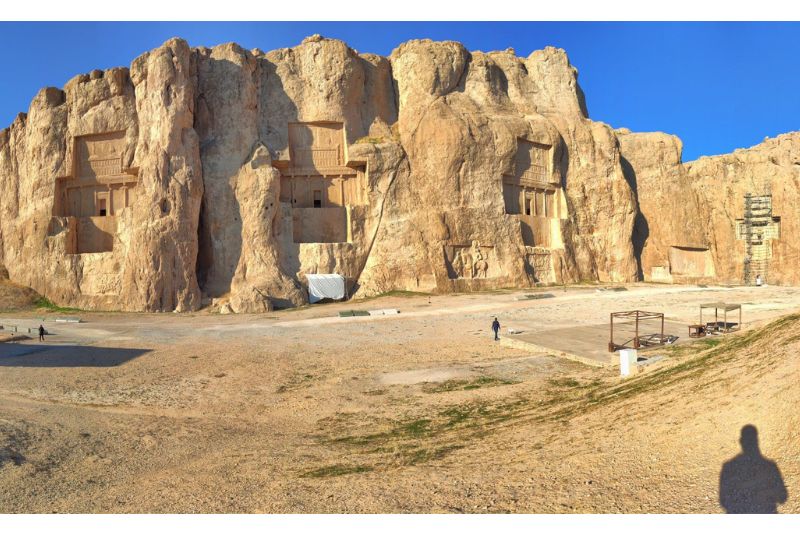
The architectural marvels of Naqsh-e Rostam are a true fusion of nature and human ingenuity. Each tomb is a product of meticulous planning, engineering, and artistic vision. Carved directly into the rock, the tombs are fronted by imposing facades, reminiscent of grand palatial entrances. The immense scale of these structures is amplified by their sheer integration into the rock, creating an imposing and unforgettable sight.
| Read more: Arg-e Bam | The Fascinating Citadel of Ancient Persia
Intricate Carvings, Reliefs, and Inscriptions
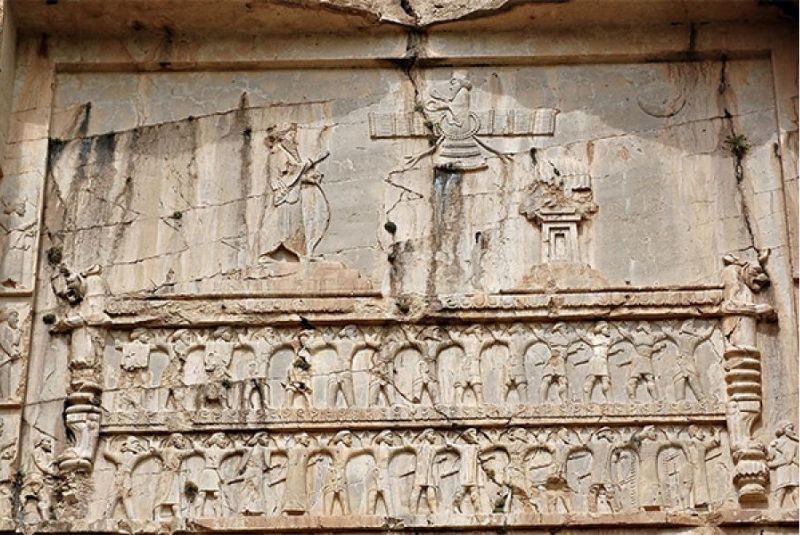
The tombs at Naqsh-e Rustam are not only architectural marvels but also galleries of ancient art and culture. Intricate carvings, reliefs, and inscriptions adorn the facades, providing a rich tapestry of stories and symbolism. These carvings offer insights into Zoroastrian beliefs, royal ceremonies, court life, and the military prowess of the Achaemenid rulers. The notable reliefs and carving of Naqsh-e Rustam are:
- Investiture of Ardashir I
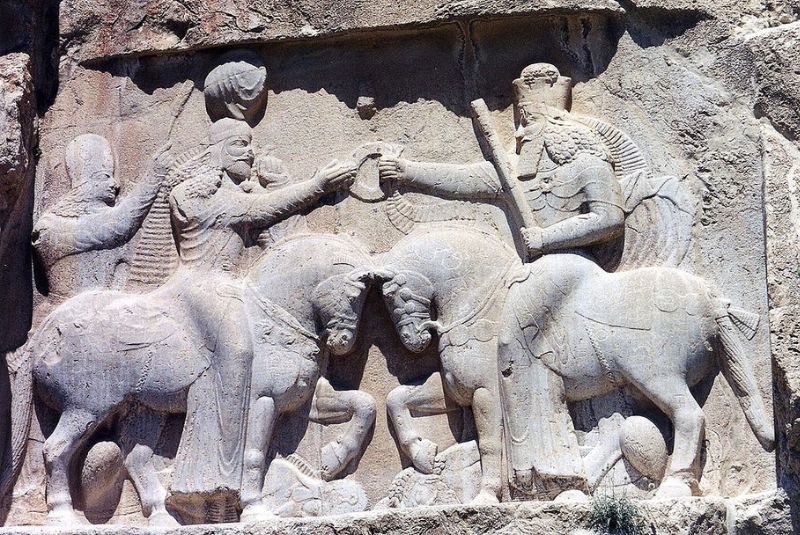
This relief portrays the triumphant scene of Ardashir I, the founder of the Sassanian Empire, receiving the diadem of kingship from Ahura Mazda, a prominent deity in Zoroastrianism. The scene symbolizes divine endorsement of Ardashir's rule and the legitimacy of his dynasty.
- Investiture Scene of Narseh
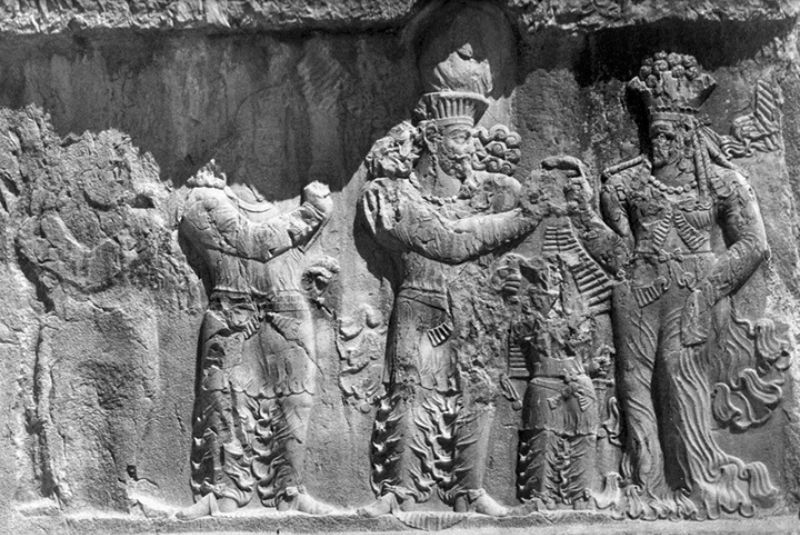
Carved during the reign of Narseh, this relief depicts the investiture of the Sassanian king by a divine figure, possibly Anahita, a goddess associated with fertility and water. The scene conveys the king's divine mandate to rule and protect the empire.
- The Scene of Valerian’s Capture
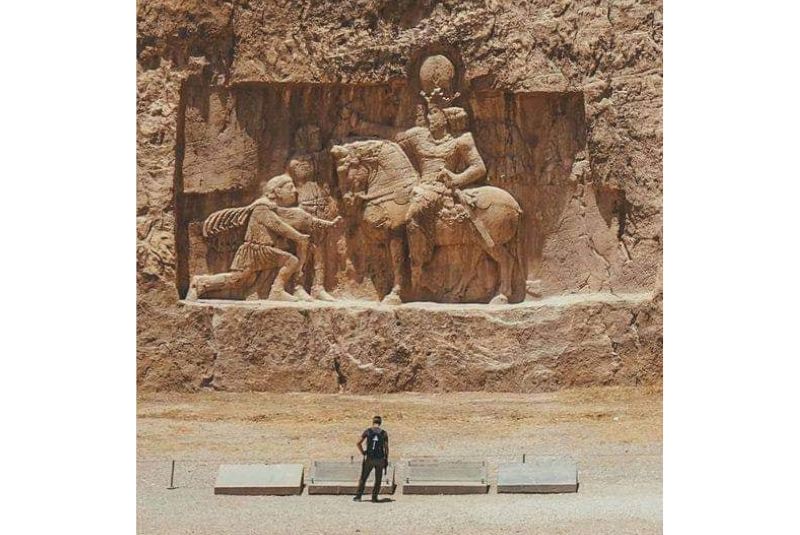
A dramatic and historically significant scene, this relief commemorates the capture of the Roman Emperor Valerian by Shapur I. Valerian is shown humbled before the victorious Sassanian king, underscoring the military prowess of the Sassanian Empire.
- Battle Scene of Shapur II
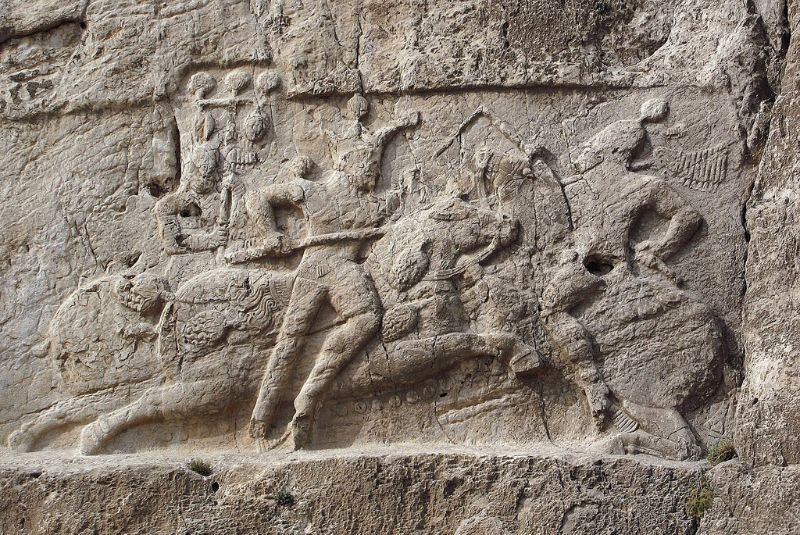
This dynamic relief depicts Shapur II, one of the most powerful Sassanian rulers, in a triumphant pose as he stands over a defeated enemy. The scene captures the martial strength and strategic brilliance that characterized Shapur II's reign.
- Darius Inscription (DNa Inscription)
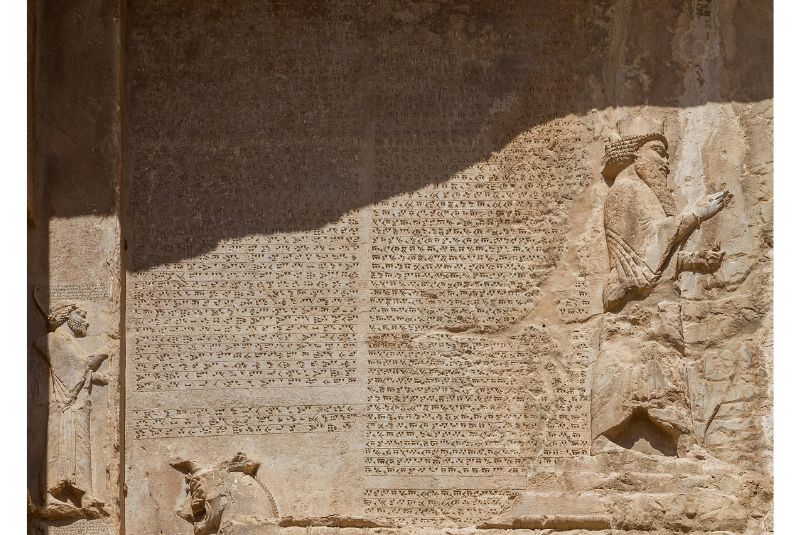
The Darius Inscription, written in cuneiform script, is a trilingual inscription in Old Persian, Elamite, and Babylonian cuneiform scripts. Carved on a vertical rock face, it recounts the accomplishments and genealogy of Darius I. The inscription provides valuable insights into the Achaemenid ruler's aspirations and achievements.
| Learn about: Takhte Soleyman | Throne of Solomon
The Kaaba of Zoroaster (Ka'ba-ye Zartosht)

Among the fascinating features of Naqsh-e Rustam is the enigmatic Kaaba of Zoroaster, a cubical structure carved into the cliffside. Often referred to as "Ka'ba-ye Zartosht," this monument holds significant importance in Zoroastrianism. Its exact purpose remains a subject of scholarly debate, with some theories suggesting it served as a fire temple or a repository for sacred texts. Regardless of its function, the Kaaba of Zoroaster stands as a testament to the enduring influence of Zoroastrianism at Naqsh-e Rostam.

Cultural and Religious Significance
Naqsh-e Rustam isn't just a collection of ancient monuments; it's a profound repository of cultural and religious significance that reflects the spiritual beliefs and aspirations of the civilizations that once thrived in these lands.
Zoroastrian Influences and Rituals
At the heart of Naqsh-e Rustam's cultural tapestry lies its deep-rooted connection to Zoroastrianism, one of the world's oldest monotheistic religions. Zoroastrianism flourished in ancient Persia, and its principles continue to leave an indelible mark on the region's history. The site's rock-cut tombs, reliefs, and inscriptions reveal a symbiotic relationship between the spiritual and temporal realms, emphasizing the importance of faith and divine endorsement in the context of governance and leadership.
| Dont miss out: Is Iran Safe for Tourists?
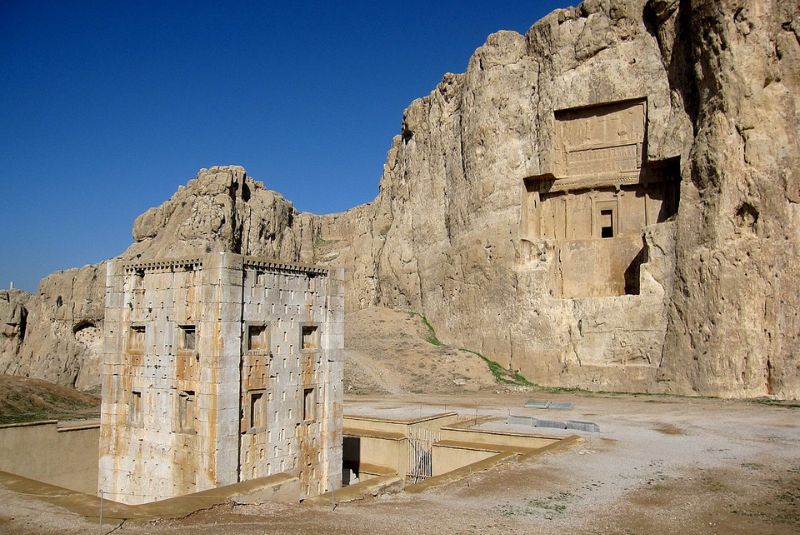
Association with the Souls of the Departed
According to Zoroastrian beliefs, Naqsh-e Rustam holds a special place in the afterlife. The souls of the departed are believed to journey to this sacred site to be judged by divine powers. The association between the souls of the departed and this monumental necropolis creates a profound link between the physical and spiritual worlds, underscoring the timeless connection between mortals and the divine.
| Suggestion: Tehran Palaces | Iran's Historical & Cultural Heritage
Pilgrimage Destination for Zoroastrians
Naqsh-e Rustam continues to be a place of pilgrimage for Zoroastrians, both from within Iran and around the world. Devotees visit this revered site to pay homage to their ancestors, to connect with their spiritual roots, and to participate in rituals that honor the memory of those who once ruled and shaped the ancient Persian realm. The act of pilgrimage to Naqsh-e Rostam serves as a way to bridge the gap between the past and the present, uniting generations under a shared cultural and religious heritage.
Best Time to Visit Naqsh-e Rustam

The best times to visit are during the mild and picturesque seasons of spring (March to May) and fall (September to November). These periods offer comfortable temperatures ranging from around 15°C to 25°C (59°F to 77°F), making them ideal for exploring the rock-cut tombs and intricate reliefs without the extremes of summer heat or winter cold.
Spring showcases a lush landscape, while fall adds colorful foliage to the serene surroundings. Avoiding the heat of summer and the possibility of winter chill, these seasons provide an optimal environment for immersing yourself in the historical and cultural wonders of this revered site.
| Discover: Persian Garden | A Piece of Paradise in Iran
Naqsh-e Rustam Visiting Hours and Entrance Fee
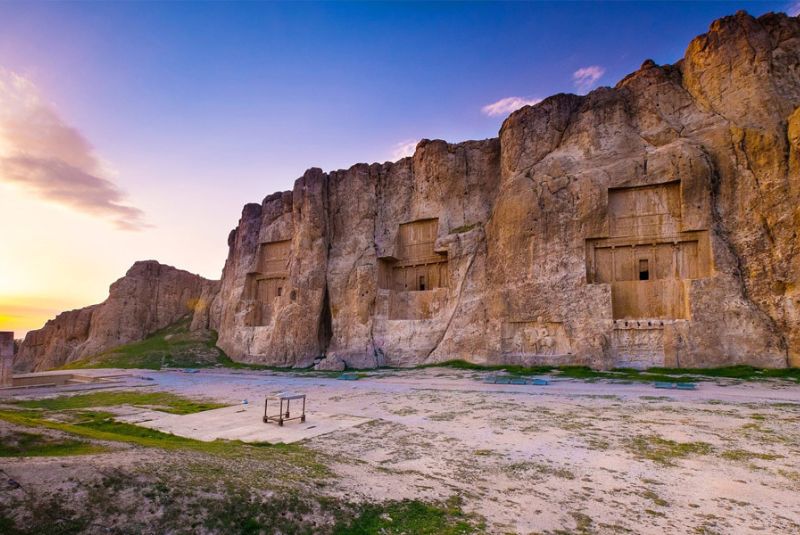
Naqsh-e Rustam welcomes visitors every day from 8 am to 7 pm, with potential variations during official holidays. The site offers a captivating journey into history and culture, allowing exploration of its ancient wonders. The entrance fee for this experience is 50,000 Iranian Tomans, providing access to the remarkable rock-cut tombs, intricate reliefs, and the profound cultural significance that Naqsh-e Rostam embodies.
How to Get to Naqsh-e Rustam
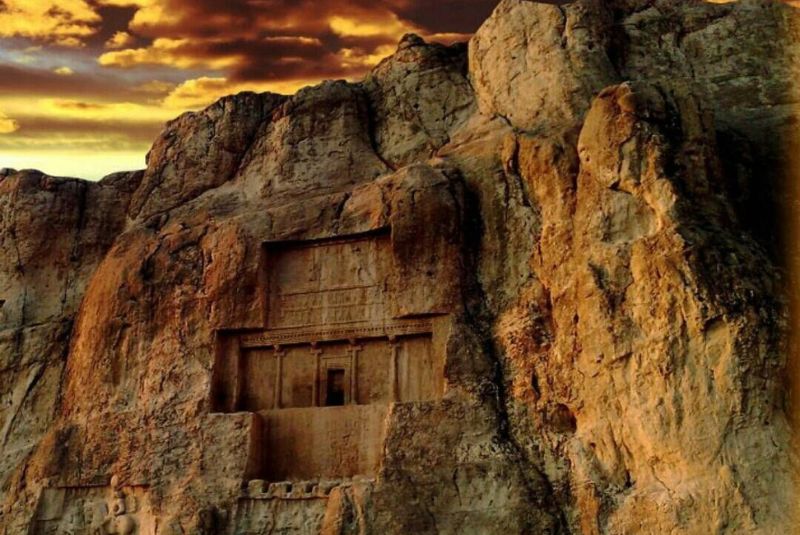
To reach Naqsh-e Rostam from Shiraz, the journey takes approximately an hour by car. Begin by heading towards the Shiraz-Persepolis road. From there, continue on the route that leads to the Marvdasht-Sadaat Shahr highway. Follow this highway until you reach the junction with the Marv Dasht-Sarooie Road. After a brief stretch on this road, you will arrive at Naqsh-e Rustam, where ancient wonders and historical treasures await your exploration.
| Suggestion: Iran's Ziggurats | Unveiling the Secrets of the Past
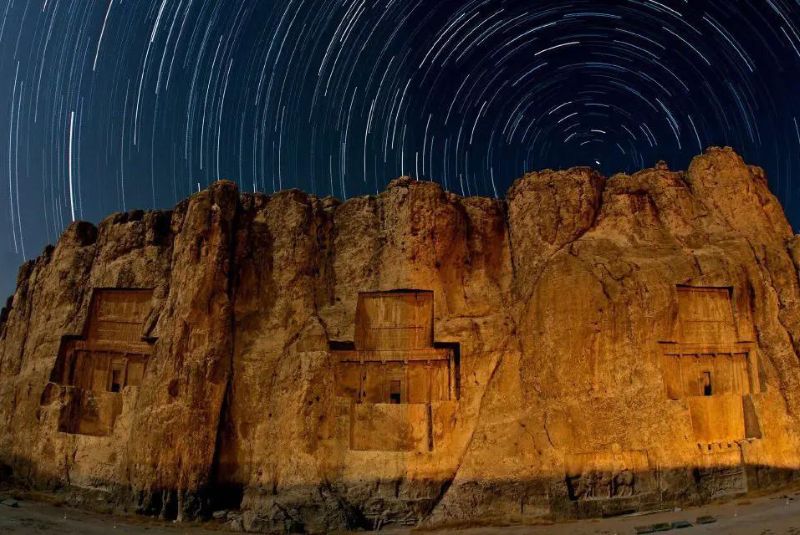
Bottom Line
From the majestic rock-cut tombs that honor legendary rulers to the intricate reliefs that speak of battles and beliefs, Naqsh-e Rustam offers a window into the civilizations that once flourished here. The spiritual ties to Zoroastrianism, the echoes of ancient rituals, and the enduring allure of this sacred site invites you to be a part of its enduring legacy.
Share your story!
Comment below and let us know about your Experience.
Your story inspires others!


Comment
Leave a Comment